130 - Modified Heller Esophagomyotomy
Editors: Shields, Thomas W.; LoCicero, Joseph; Ponn, Ronald B.; Rusch, Valerie W.
Title: General Thoracic Surgery, 6th Edition
Copyright 2005 Lippincott Williams & Wilkins
> Table of Contents > Volume II > The Esophagus > Section XXIV - Malignant Lesions of the Esophagus > Chapter 153 - Less Common Malignant Tumors of the Esophagus
function show_scrollbar() {}
Chapter 153
Less Common Malignant Tumors of the Esophagus
Gordon F. Murray
Michael F. Szwerc
The less common malignant tumors of the esophagus share the all too common clinical behavior and pathologic features of typical epidermoid carcinoma and adenocarcinoma of the esophagus. The poor outcome for patients with squamous cell carcinoma and adenocarcinoma persists despite advances in diagnostic and surgical techniques. Survival rates for patients with rare primary epithelial malignant lesions of the esophagus are equally discouraging. Neither cell type nor degree of histologic differentiation is significant in the prognosis, which is uniformly poor, regardless of the treatment received. The uncommon polypoid carcinomas and sarcomas of the esophagus have a somewhat better prognosis when amenable to resection, but spread beyond the esophagus is rapidly fatal. Thus, cancer of this mediastinal organ, however rare the specific tumor may be, is often lethal.
Table 153-1 lists malignant tumors of the esophagus other than typical epidermoid carcinoma and adenocarcinoma. The unusual glandular carcinomas include cylindroma, mucoepidermoid carcinoma, and adenoacanthoma. Less common epitheliomatous lesions of the esophagus are verrucous carcinoma and polypoid carcinoma. Neuroendocrine carcinoma and melanoma also occur. Of the few remaining primary esophageal malignant tumors, true sarcomas are most notable. Rarely, the esophagus may be involved by metastatic tumor.
EPITHELIAL TUMORS
Only rarely is esophageal adenocarcinoma explained by primary neoplastic change within the squamous epithelium-lined esophagus. In the 1960s, Turnbull and Goodner (1968) found primary adenocarcinoma of the anatomic esophagus in only 45 of 1,859 patients with esophageal cancer. Similar carefully documented studies in the mid-1960s established that primary adenocarcinomas, other than those at the gastroesophageal area, composed about 3% of all esophageal carcinomas. However, in recent years (1980s and 1990s), adenocarcinoma of the esophagus has become the most rapidly increasing solid cancer in America. According to Blot (1993), Devesa (1998), and El-Serag (2002) and their associates, as well as Blot and McLaughlin (1999), adenocarcinoma has replaced squamous cell carcinoma as the most common malignant lesion of the esophagus, and its incidence continues to increase in all age groups in the United States. As noted by Jemal and colleagues (2002) there were about 12,600 deaths due to this malignancy in a single year. Adenocarcinoma of the esophagus and gastroesophageal junction is discussed in detail in Chapter 150.
A review of glandular epithelial structures that may occur within the esophagus is essential for understanding the development of esophageal adenocarcinoma. Only a few sources of columnar epithelium in the esophagus have been recognized (Fig. 153-1). Superficial and deep submucosal glands constitute part of the normal anatomy of the esophagus. Heterotopic islands of aberrant gastric mucosa occur in many organs of the body, including the esophagus. Only since the 1950s has the acquired nature of the columnar epithelium-lined lower esophagus (Barrett's metaplasia) been appreciated, and Barrett's metaplasia is now thought to be the most common underlying pathologic process that may progress into frank, typical adenocarcinoma of the esophagus. Detailed discussions of Barrett's metaplasia are presented in Chapters 147 and 150. The columnar epithelium in all these aforementioned locations may become a site of malignant change. In Barrett's metaplasia, only the intestinal type of columnar epithelial cells is believed to be premalignant.
Unusual Variants of Adenocarcinoma
The superficial esophageal glands arise in tall columnar epithelium, which Johns (1952) noted in the embryo. Localization
P.2326
of the superficial glands to the upper and lower ends of the adult esophagus corresponds to the embryonal foci of the columnar epithelium. These mucus-secreting glands occupy an area in the lamina propria and are indistinguishable from the cardiac glands of the stomach. Although Hewlett (1900) suggested that these glands might give rise to adenocarcinoma, documented instances are difficult to find. Nevertheless, Goldman (1952) and Raphael (1966) and their associates and Scicchitano and Camishion (1962) described malignant lesions that probably arose from the superficial glands of the esophagus. The well-illustrated case report by Goldfarb (1967) removes all doubt that adenocarcinoma can arise from the cardiac submucosal glands of the esophagus. The histologic structure of these lesions is adenocarcinoma type ordinaire, as commonly seen in the stomach.
Table 153-1. Less Common Malignant Tumors of the Esophagus | |
|---|---|
|
Deep esophageal submucosal glands develop mainly during the postnatal period and are found throughout the length of the esophagus. Columnar cells line the ducts that pierce the muscularis mucosa and extend to the squamous epithelium. Although deep glands secrete mucus, serous cells may be found, which can create an appearance indistinguishable from minor salivary glands. Esophageal adenoid cystic carcinoma or cylindroma (Fig. 153-2) is incontrovertible evidence of primary esophageal glandular carcinoma, a tumor well known in the major salivary glands and oropharyngeal region but with no counterpart in the stomach. Azzopardi and Menzies (1962) reported four examples of cylindroma in the
P.2327
esophagus that were histologically identical to those found in the salivary glands. Rarely, true mucoepidermoid tumors that have a histologic resemblance to lesions of the major salivary glands are observed in the esophagus. These tumors show distinct epidermoid features with histologic evidence of mucus-secretory properties. Such tumors may also arise in the deep submucosal glands of the esophagus. Because of their submucosal origin, these tumors often manifest as intramural masses. Another variant, adenosquamous carcinoma, is similar to mucoepidermoid carcinoma, showing both epidermoid and glandular components, noted by Brocheriou (1991) and Bombi (1991) and their co-workers. Mucoepidermoid carcinomas may demonstrate both in situ and infiltrative components along with pagetoid spread to the surface epithelium, analogous to Paget's disease of the breast, as was first reported by Yates and Kloss (1968) and most recently Haleem and associates (2003).
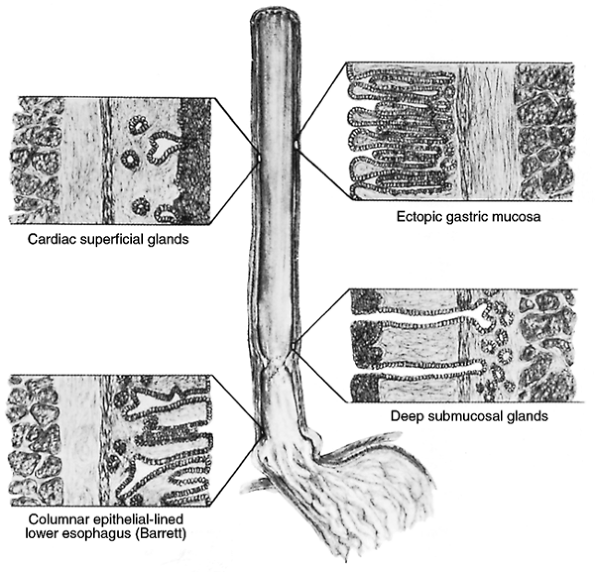 |
Fig. 153-1. Sources of columnar epithelium in the esophagus recognized in the origin of primary esophageal adenocarcinoma. |
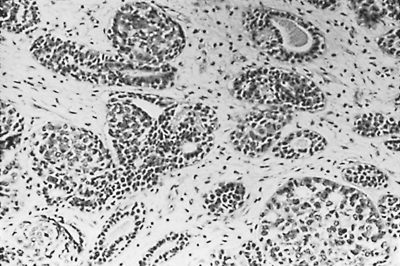 |
Fig. 153-2. Adenoid cystic carcinoma of the esophagus. From Sobin LH: Histologic Typing of Gastric and Oesophageal Tumours. Geneva: World Health Organization, 1977. With permission. |
Islands of gastric mucosa sometimes replace portions of the squamous lining of the esophagus (Fig. 153-3). These areas of heterotopic epithelium usually consist of cardiac glands, but they may contain parietal cells. Rector and Connerly (1941) found patches in 7.8% of 1,000 consecutive pediatric autopsies; the heterotopic tissue was found more often in the upper one third of the esophagus. Postlethwait and Musser (1974) found one neonatal esophagus lined completely by columnar epithelium among 200 specimens studied. Carrie (1950) was the first to report an example of adenocarcinoma arising from a patch of ectopic gastric epithelium; this source of origin is now established. In situ malignant changes can be found in remnants of heterotopic epithelium, and the tumor is morphologically indistinguishable from gastric carcinoma. A variant of adenocarcinoma displays a concomitant squamous metaplastic element and has been designated adenoacanthoma. The lesion is a well-differentiated adenocarcinoma with groups of squamous cells surrounded by glandular tumor. Distinct from these tumors is the squamous cell carcinoma with pseudoglandular degeneration characterized by lack of mucus secretion and the rare composite adenosquamous malignancy with aggressive glandular and epidermoid elements. McKechnie and Fechner (1971) suggested that metaplasia of esophageal adenocarcinoma forms hormonally active choriocarcinoma. This tumor is rare, and it may be a giant cell variant of adenocarcinoma that is attempting trophoblastic differentiation.
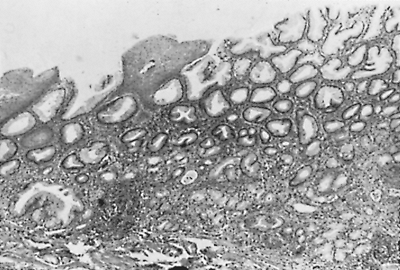 |
Fig. 153-3. Gastric heterotopia, upper esophagus. From Sobin LH: Histologic Typing of Gastric and Oesophageal Tumours. Geneva: World Health Organization, 1977. With permission. |
Treatment
Surgical resection has been the mainstay of treatment for these unusual variants of adenocarcinoma of the esophagus. Extensive infiltration of the wall and lymphatics is common; therefore, frozen-section examination of the proximal margin is advisable. Palliative radiation therapy may result in a gratifying clinical response in a few patients for up to 1 year. Only surgical excision permits survival of 5 years or more. Lieberman and associates (1995) demonstrated that histologic type is not an independent predictor of survival in patients undergoing curative resection for carcinoma of the esophagus and the gastroesophageal junction. Outcome is most strongly influenced by the extent of disease, defined by T and N stage.
Prognosis
The prognosis for these variants of adenocarcinoma of the esophagus is uniformly poor. As in the typical adenocarcinoma, mucoepidermoid tumors of the esophagus show a high degree of malignancy. They are extensively invasive, and metastases are generally present. Ming (1973) emphasized that the relatively benign course of adenocystic carcinomas found in other areas is not applicable to esophageal lesions. The latter generally demonstrate extensive intramural spread, and distant metastases are frequent. Allard and associates (1981) reported a case in a 75-year-old man. They suggested treating such tumors in the same manner as squamous cell carcinoma, (i.e., by radical surgical excision).
P.2328
Unusual Variants of Squamous Cell Carcinoma
Verrucous Carcinoma
A distinct morphologic variant of squamous cell carcinoma of the esophagus is verrucous carcinoma. This tumor is a papillary or warty, cauliflowerlike epidermoid growth that is well differentiated histologically and shows acanthosis and hyperkeratosis (Fig. 153-4). Verrucous squamous carcinoma is found most frequently in the oral cavity. It has also been found on the larynx, glans penis, vulva, endometrium, bladder, and anorectal region. Verrucous carcinoma of the esophagus is rare. Minielly and colleagues (1967) found only five instances among all esophageal carcinoma cases seen at the Mayo Clinic since 1906. Chronic retention of esophageal contents may have contributed to the development of these verrucous lesions. Two of the patients had a history of long-standing achalasia, and in two patients, a diagnosis of esophageal diverticulum had been made several years before the discovery of esophageal carcinoma. The two surgical specimens showed a moderate degree of associated leukoplakia. Although leukoplakia is commonly associated with verrucous squamous carcinoma in other sites, such as the oral cavity or penis, it is rarely encountered in the esophagus, except in association with achalasia or esophageal diverticulum.
The natural history of verrucous squamous carcinoma in the esophagus, as in other sites, is that of a slow-growing but gradually invasive neoplasm. The relatively low yield from mucosal biopsies frequently demonstrates acanthosis, hyperkeratosis, and parakeratosis. The uses of endoscopic ultrasound can provide valuable information in the diagnostic process. Meyerowitz and Shea (1971) reported a patient with a verrucous carcinoma at the lower end of the esophagus. The tumor had been present apparently for about 7 years before diagnosis and surgical resection, which illustrates the indolent growth of verrucous carcinoma. The slowly progressing infiltrative tumor characteristically becomes large, but distant metastasis has never been reported. Lymph nodes adjacent to the tumor may become involved by direct extension of the tumor. Diagnosis may be difficult because growth is well differentiated and the biopsy specimen may not be deep enough to demonstrate invasion. Biemond and colleagues (1991) emphasized that it may be difficult to distinguish this tumor from squamous cell papilloma. Early recognition of the lesion requires clinical suspicion of this growth, particularly in the presence of achalasia or esophageal diverticulum.
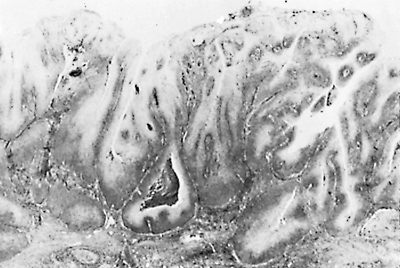 |
Fig. 153-4. Verrucous squamous cell carcinoma of the esophagus with typical blunt contours of deep margin. From Sobin LH: Histologic Typing of Gastric and Oesophageal Tumours. Geneva: World Health Organization, 1977. With permission. |
Verrucous carcinoma of the esophagus, as in other sites, ideally should be treated by en bloc surgical resection; radiation therapy alone is not an advisable form of therapy. Goethals and associates (1963) stated that irradiation may cause a tumor to regress, but the treatment may also make the low-grade lesion anaplastic and aggressive. Irradiation rarely affects a cure. Because verrucous carcinoma of the esophagus follows the usual growth pattern of this tumor elsewhere in the body, the outlook for these patients should be more favorable than it is for patients with the usual type of epidermoid carcinoma. Nonetheless, most patients in whom verrucous carcinoma of the esophagus has been documented have died as a result of their tumors. Minielly and colleagues (1967) explained the poor prognosis of this esophageal lesion by noting the close proximity of vital mediastinal structures, the technical hazards of esophageal resection, and the frequent delay in diagnosis. Thus, early recognition, along with a reduction in operative mortality by improved surgical techniques, may result in a better prognosis for these patients. Malik and associates (1996) reported a 22-month survivor who had undergone a wide surgical excision. Osborn and colleagues (2003) recently reviewed the topic and available clinical literature.
Polypoid Carcinoma
Polypoid carcinoma with spindle cell sarcomatous features is a rare variant of squamous carcinoma, seen most commonly in the mouth, fauces, and upper respiratory tract and less often in the esophagus. When these tumors are present in the esophagus, they are usually in the middle one third. In other areas, these tumors often develop apparently in response to radiation therapy for either benign conditions or typical squamous carcinoma, but this association has not been reported for esophageal lesions. The exophytic esophageal tumors have been termed either carcinosarcoma or pseudosarcoma, based on the degree of intermingling and metastatic potentiality of carcinomatous and sarcomatous elements. Hence, carcinosarcoma is characterized histologically by the presence of intimate mingling of the carcinomatous and sarcomatous elements in the primary tumor; metastatic potential is assigned to either the epithelial or sarcomatous component, or to both. By contrast, in pseudosarcoma, the carcinomatous element, in situ or invasive, is confined to the surface epithelium near the base of the polyp (Fig. 153-5). Only the carcinomatous component of
P.2329
polypoid pseudosarcoma has been considered to have metastatic potential, but Martin and Kahn (1977) and Osamura and associates (1978) described polypoid esophageal malignancies with all the morphologic features of pseudosarcoma and definite evidence of metastasis of the spindle cell element (Fig. 153-6). Matsusaka and associates (1976b) did not demonstrate any significant differences in the clinicopathologic features of carcinosarcoma and pseudosarcoma. Thus, no important distinction can be made between the two tumors, and consequently Osamura and colleagues (1978) proposed the unifying term polypoid carcinoma. Kimura and colleagues (1989) described four cases of esophageal polypoid tumors, which they concluded were carcinosarcomas composed of both squamous cell carcinoma and leiomyosarcoma.
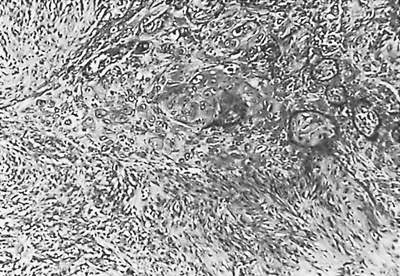 |
Fig. 153-5. Focus of squamous carcinoma in the upper half of this photomicrograph adjacent to sarcoma in the lower half of a section from the base of a polyp (hematoxylin and eosin, original magnification times 125). From Martin MR, Kahn LB: So-called pseudosarcoma of the esophagus. Arch Pathol Lab Med 101:607, 1977. With permission. |
The idea that the sarcomatous elements of polypoid carcinoma arise from transformation of squamous cells was proposed at the turn of the century, and this viewpoint represents the current consensus. Electron microscopic studies supporting the squamous origin of the sarcomatous cells resolved the controversy. Shields and colleagues (1972) reported the first electron microscopic study of a polypoid carcinoma of the esophagus (Fig. 153-7). Many cells exhibited desmosomal attachment to neighboring cells with well-developed junctional complexes that included tonofilaments (Fig. 153-8). Numerous typical branching tonofibrils
P.2330
were seen in a few cells (Fig. 153-9). Tonofibrils are found only in epithelial cells, predominately squamous types, and are thought to be related to the process of keratinization. Well-developed, tonofilament-associated desmosomes are also common in epithelial tumors, especially in those of squamous cell origin. Thus, Shields and associates (1972) concluded that the spindle-shaped cells in the polypoid tumor originated from squamous cells. Battifora (1976) described further ultrastructural evidence of the squamous origin of the spindle cell element of polypoid esophageal carcinoma. From these findings, it was suggested that the sarcomatous component of the tumor originates from mesenchymal metaplasia of squamous cells and that these metaplastic cells produce collagen. On the basis of immunohistochemical analysis, however, Kimura and colleagues (1989) suggested that the anaplastic cells have a myogenic origin.
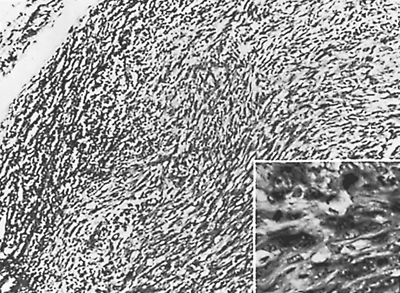 |
Fig. 153-6. Metastatic sarcoma in lymph node. (Inset) Detail of spindle cells and several mitoses, including abnormal forms. (Hematoxylin and eosin stain, original magnification times 125; inset, original magnification times 320). From Martin MR, Kahn LB: So-called pseudosarcoma of the esophagus. Arch Pathol Lab Med 101:607, 1977. With permission. |
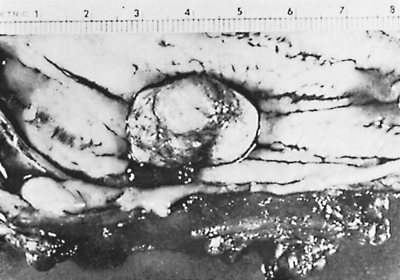 |
Fig. 153-7. Polypoid pseudosarcoma of the esophagus. From Shields TW, et al: Pseudosarcoma of the esophagus. Thorax 27: 474, 1972. With permission. |
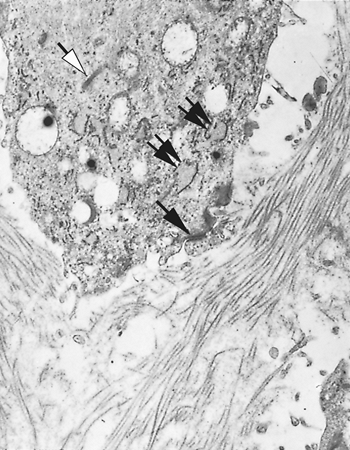 |
Fig. 153-8. Electron micrograph of pseudosarcoma of the esophagus shows a portion of a spindle cell and a small segment from another cell. At point of contact, a well-developed desmosome is present (solid arrow). The cytoplasm is rich in tonofilaments that, in places, form bundles (hollow arrow). Several distended cisternae of rough endoplasmic reticulum are visible (double arrows). Collagen fibers abound in the vicinity of the cell (original magnification times 22,000). |
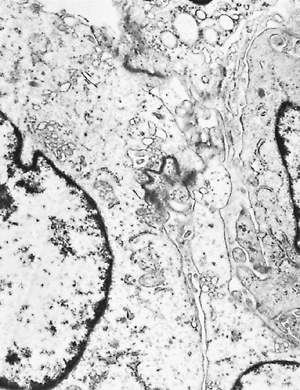 |
Fig. 153-9. Electron micrograph of pseudosarcoma of the esophagus shows the contact site of four tumor cells. Well-developed desmosomes are prominent and numerous (original magnification times 22,000). |
Wide surgical resection for polypoid carcinoma of the esophagus is the treatment of choice and most effectively palliates the obstructive symptoms, dysphagia and pulmonary aspiration. The extent of surgical resection and requisite reconstruction of gastrointestinal continuity depends on the level of the lesion rather than the estimated degree of malignancy. Recurrence of the tumor is frequent after local excision. Radiation therapy has met with only limited success. Sasajima and associates (1989), however, reported a 5-year survival rate of 71% for patients with these polypoid tumors.
Although a clear correlation between gross appearance and biological behavior has not been established, polypoid carcinoma carries a better prognosis than does typical squamous cell carcinoma of the esophagus because it rarely penetrates deeply into the esophageal wall. Diagnosis may occur earlier because the polypoid pattern of growth generally results in early obstructive symptoms. Tumors up to 15 cm wide have been reported. Rapid growth of such tumors has been documented by Sasajima and co-workers (1988), with a doubling time of 2.2 months. At the time of evaluation, extraesophageal disease is usually absent; local invasion and metastases occur late, if at all. Early reported deaths were most often caused by complications of reconstructive surgery. Reports of long-term survival with wide surgical excision support the conclusion that polypoid carcinoma often is potentially curable.
Neuroendocrine Tumors of the Esophagus
Small Cell Carcinoma
Since its original description by McKeown in 1952, small cell carcinoma (neuroendocrine tumor, type IV) of the esophagus (also referred to as oat cell, anaplastic carcinoma, or APUDoma) has been recognized as a rare but aggressive tumor characterized by early metastasis and limited median survival. It has a striking morphologic and biological resemblance to small cell carcinoma of the lung. About 5% of small cell carcinomas have an extrapulmonary origin and have been described as originating from organs such as the nasal cavities, salivary glands, paranasal sinuses, larynx, hypopharynx, esophagus, thymus, pancreas, small and large intestine, and stomach. Bensch and associates (1968) showed that pulmonary small cell carcinoma tumors are endocrine polypeptide-producing tumors (APUDomas) derived from cells that resemble argentaffin (Kulchitsky's) cells of the intestinal tract. These cells, which possess long cytoplasmic processes, contain characteristic cytoplasmic granules, referred to as neurosecretory-type granules, which display argyrophilic properties (brown staining of tissue after the reduction of silver ions). Because of the embryologic derivation of the esophagus from the foregut, it is reasonable to expect argyrophilic neurosecretory cells in the esophagus. Tateishi and co-workers (1974) demonstrated argyrophilic cells in the basal epithelium of the normal human esophagus. Matsusaka and associates (1976a) found intracytoplasmic argyrophilic granules in three autopsy specimens of esophageal anaplastic carcinoma with a small cell pattern. Tateishi and colleagues (1976) used electron microscopy, along with an assay for adrenocorticotropic hormone content, to study six patients with esophageal malignancies resembling pulmonary small cell carcinoma. Three of the tumors had neurosecretory-type granules, and adrenocorticotropic hormone activity was detected by bioassay or radioimmunoassay in three of four tumors tested. These authors concluded that small cell carcinoma of the esophagus represents a distinct histopathologic
P.2331
entity (neuroendocrine tumors) clearly distinguishable from other types of esophageal carcinoma.
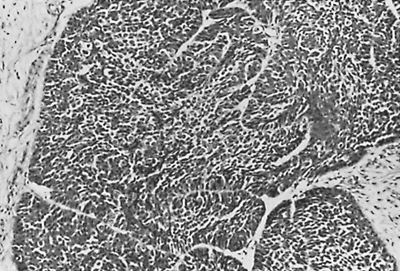 |
Fig. 153-10. Undifferentiated carcinoma of the esophagus. A distinct form referred to as small cell carcinoma is described in the text. From Sobin LH: Histologic Typing of Gastric and Oesophageal Tumours. Geneva: World Health Organization, 1977. With permission. |
These esophageal tumors are histologically identical to small cell carcinoma of the lung. They are composed of uniform small cells with hyperchromatic nuclei and little cytoplasm. The undifferentiated cells are arranged in solid sheets or ribbon and streaming patterns (Fig. 153-10). Cook and colleagues (1976) emphasized that squamous cell carcinoma is often found near the esophageal small cell lesion; this has also been noted by Sato and associates (1986). The precise histogenetic relationship of the two tumor components is not clear, but derivation from the same cell of origin with divergent differentiation is possible.
Small cell carcinomas of the esophagus appear to behave like their pathologic counterparts in the lung. The esophageal small cell carcinoma is the anaplastic, highly malignant form of the neuroendocrine cell tumors. These tumors usually are fungating, polypoid lesions that ulcerate and are most often found in the middle or lower one third of the esophagus. Most tumors have been identified at postmortem examination, which usually reveals extensive metastases.
There are fewer than 200 cases reported in the world literature. As such, it is difficult to make a meaningful analysis of an effective therapeutic regimen. Caldwell (1991) and Beyer (1991) and their colleagues each presented separate series of 11 patients. Despite surgical resection in combination with chemotherapy and radiation therapy, these tumors remained difficult to control. Recently, Pantvaidya and co-workers (2002) reported a series of 18 cases with an overall median survival of 6 months. Craig and associates (1995) have reported a single long-term survivor of more than 96 months who was treated with resection and postoperative chemotherapy. Hama and associates (1999) reported long-term survival of a patient with a cervical small cell cancer treated with chemoradiation therapy. Yachida and co-workers (2001) reported the long-term survival (7 years) of a patient who was treated by subtotal esophagectomy and extended lymph node dissection without adjuvant chemotherapy. In a review of the literature, Casas and associates (1997) concluded that the treatment of small cell tumors could be separated into two groups. Patients presenting with tumors confined to the esophagus were classified as limited stage; those presenting with tumors extending outside the esophagus and associated with lymph node metastases were classified as extensive stage. In the limited stage, favorable prognostic factors included a tumor size of less than 5.0 cm and a therapeutic regimen of a combination of local and systemic treatment. Mitani and colleagues (2000) reported that for patients with small cell carcinoma of the esophagus with invasion limited to the submucosal layer, long-term survival with resection is possible. The most important prognostic factor in patients presenting with extensive-stage disease was their ability to tolerate either local or systemic treatment, or both. The application of treatment was most influenced by the patient's performance status on presentation. Huncharek and Muscat (1995), as well as Nishimaki and associates (1997), have independently reported results that reflect the extensive review by Casas and colleagues (1997).
By extension of the management of small cell carcinoma of the lung, esophageal small cell carcinoma is currently treated with chemotherapy and radiation therapy, usually administered concurrently. Chemotherapy regimens, including cisplatin and etoposide, are commonly used. Carboplatin and etoposide may be considered in elderly or poor-risk patients with limited reserve or impaired renal function. Surgery is reserved for salvage resection of persistent primary tumor after chemoradiation therapy.
Carcinoid Tumors of the Esophagus
Carcinoid tumors of the esophagus are rare, and the first case reported in the literature was published by Brenner and associates in 1969. Since that time, Lindberg and colleagues (1997) recorded one case and reviewed 13 cases [including that of Brenner and associates (1969)]. Subsequently, Soga (1998) evaluated the multiphasic clinical and pathologic features of 100 cases reported in the world literature of carcinoid tumors of the esophagus. Twenty-eight cases were of the typical variety, and 72 were of the atypical type. The lesions were found predominantly in men (6:1) and in an older age group. The tumors were located in the submucosa of the lower esophagus, although other regions of the esophagus were not spared, and the tumors ranged in size from 1 to 12 cm. Dysphagia and weight loss were the common symptoms. The typical carcinoids were as a rule smaller in size, were confined to the lamina propria, and had a low incidence of metastasis. Response to surgical removal was satisfacatory in most cases. The incidence of a carcinoid syndrome was not noted separately for this group of tumors.
The atypical carcinoid tumors tended to be larger in size, the muscular layer of the esophagus was often invaded, and
P.2332
lymph node metastases were common. Distant metastasis was noted in a number of patients. The incidence of carcinoid syndrome was low. Of additional interest was the finding of an association with adenocarcinoma arising in the background of Barrett's esophagus in four patients: one each recorded by Chong (1979) and Juarez (1986) and their colleagues and two patients by Hoang and co-workers (2002). When the atypical carcinoid is localized, surgical intervention may be curative. However, when metastases or local infiltration are present, the outlook is poor despite radical resection and adjuvant postoperative therapy of radiation therapy, chemotherapy, or both. Even with combined therapy, an atypical carcinoid may be rapidly fatal, as noted in the case report of Xiaojang and associates (2002).
Melanoma
Primary malignant melanoma of the esophagus is a rare disease, accounting for 0.1% to 0.2% of malignant diseases of the esophagus (Fig. 153-11). De La Pava and colleagues (1963) found typical melanoblasts with melanin granules and dendrites in the basal layer of the esophageal epithelium in 4 of 100 normal esophagi studied. These authors speculated that the melanoblasts, present in the upper one third of the esophagus in two specimens and in the middle in two specimens, migrated to the esophagus from the neural crest. Piccone and associates (1970) reported a primary malignant melanoma of the esophagus associated with esophageal melanosis, with a first report for primary melanoma together with melanosis of the entire esophagus. The absence of melanosis in most melanomas of the esophagus indicates that the tumor more commonly originates in some other way: from some of the few normally occurring melanoblasts, from metaplasia of normal basal epithelial cells of the esophagus, or from ectopic melanoblast-containing epithelium that arose within the esophagus during development.
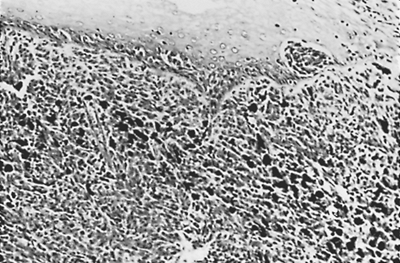 |
Fig. 153-11. Malignant melanoma of the esophagus. The primary tumor is heavily pigmented. From Sobin LH: Histologic Typing of Gastric and Oesophageal Tumours. Geneva: World Health Organization, 1977. With permission. |
The presence of junctional changes in the overlying or adjacent epithelium is considered unequivocal evidence of a primary cutaneous malignant melanoma. Allen and Spitz (1953) broadened the concept of junctional change as an essential criterion of primacy to include visceral melanoma. Optimally, the diagnosis of primary esophageal melanoma should be based on the following criteria: (a) the tumor should have the characteristic histology of melanoma and it should contain melanin; (b) the tumor should arise from an area of junctional change in squamous epithelium; (c) the adjacent epithelium should demonstrate junctional change with the presence of melanin-containing cells; (d) careful evaluation must exclude skin, ocular, or anal mucosal primary melanomatous malignancy; and (e) a positive reaction to the monoclonal antigen HMB-45 should be present.
In the esophagus, a rapidly growing tumor may ulcerate into the adjacent epithelium. Direct origin from junctional epithelium may be difficult to establish clearly. On the other hand, Eng and associates (1989) noted that metastatic malignant melanoma of the esophagus has been reported only rarely. This infrequent reporting is curious because melanoma in the stomach or small bowel is almost always a secondary deposit. Schneider and associates (1993) reviewed the world's literature on malignant melanoma metastatic to the esophagus. They found that no patients survived for 1 year. This led them to conclude that the appropriate treatment of malignant melanoma metastatic to the esophagus should be palliative.
Most primary esophageal melanomas have a shaggy, polypoid radiographic appearance, unlike metastatic lesions that usually involve the muscularis and appear extrinsic and smooth in contour. Remarkably, the primary tumor often grows to considerable size within the esophageal lumen before obstructive symptoms appear. Odynophagia is a prominent symptom, probably related to the frequent finding of ulcerated mucosa. The characteristic finding at endoscopy is a lobulated tumor situated on a wide pedicle in the lower or middle esophagus. Gross pigmentation is present to a varying degree, and the tumor may be black, brown, or gray. Most tumors are ulcerated and friable and bleed easily. Usually, a single melanoma is present, but satellite lesions may be seen. The nature of the tumor should be determined by direct biopsy. Joob and associates (1995) have suggested that prompt immunohistologic study of all suspicious obstructing polypoid lesions of the esophagus should be carried out using the specific monoclonal antigen HMB-45; this reaction is specific for the diagnosis of a melanoma.
Because these tumors exhibit wide lateral growth, Sabanathan and Eng (1990) suggest that radical surgical excision with restoration of swallowing offers the best palliation of symptoms and generally the only hope for cure. Radiation therapy has been ineffective, and a role for chemotherapy has not been defined. Immunoscintigraphy has been suggested as an appropriate evaluation to identify the presence of metastatic disease. The esophageal lesion is
P.2333
no less fatal than malignant melanoma found elsewhere in the body. The prognosis is grave because widespread disease usually develops rapidly, followed by a fulminating, deteriorating clinical course. Spread to the regional lymph nodes is most frequent, and the lungs, liver, and pancreas are often sites of distant metastases. Most patients die of their disease within 2.5 years of its discovery and treatment, and nearly one half die within 6 months. Chalkiadakis and associates (1985) reported a 5-year survival rate of only 4.2%. Surgical resection should be contemplated for all patients as possibly a curative but more likely a palliative procedure. Because of the small number of patients reported in the world literature, meaningful treatment strategies are hard to extrapolate from the paucity of data. Combination therapy, including radical resection and chemotherapy, has been tried with limited success, as reported by Matsutani (2001) and Makino (2002) and their co-workers. Chemotherapeutic regimens include dacarbazine (DTIC), nimustine hydrochloride (ACNU), and vincristine (VCR) (DAV therapy). Herman and colleagues (2001) reported a combination of endoscopic ablation and interferon therapy resulting in a 25-month disease-free interval in a case report.
MALIGNANT MESENCHYMAL TUMORS
Sarcomatous lesions of the esophagus are rare. Leiomyosarcoma is the most frequent sarcoma, and leiomyoma is the most common benign esophageal tumor. Rhabdomyosarcoma is far less common. The distinguishing pathologic feature of these myogenic tumors is their frequently pedunculated gross configuration. In this regard, they may resemble benign esophageal polyps and tumors, and the surgeon must be alert to the malignant potential of the polypoid esophageal lesion. The polypoid sarcoma tends to remain superficial within the wall of the esophagus, and nodal or distant metastasis seldom occurs. Thus, esophageal sarcoma, unlike esophageal carcinoma, has a favorable prognosis after successful surgical resection.
Leiomyosarcoma
Leiomyosarcoma is found more often in men than in women (2:1), although it is more common in women than is squamous cell carcinoma. The age incidence of the two malignancies (squamous cell carcinoma and leiomyosarcoma) is much the same. Leiomyosarcomas are equally distributed throughout the esophagus, despite the relative paucity of smooth muscle in the proximal one third. The tumor is usually a bulky, polypoid intraluminal mass that may reach great size before producing obstructive symptoms (Fig. 153-12A). Infiltration into adjacent structures occurs occasionally. In a review of stromal tumors of the upper gastrointestinal tract, Miettinen and co-workers (2002) found only 3 leiomyosarcomas, as compared with 48 leiomyomas, in the esophagus, an incidence of 5.8%. The simultaneous occurrence of leiomyosarcoma and squamous cell carcinoma as separate tumors in the esophagus is rare.
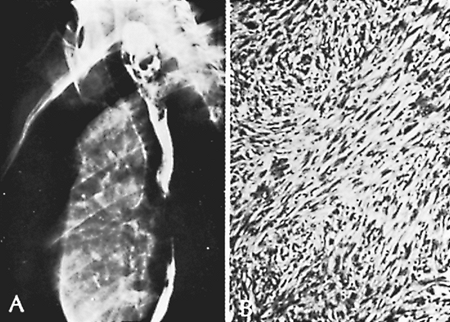 |
Fig. 153-12. Leiomyosarcoma. A. Barium swallow shows a polypoid mass in the upper thoracic and cervical esophagus. B. Photomicrograph of the polyp demonstrates large spindle-shaped cells with numerous mitoses. (Hematoxylin and eosin stain, original magnification times 150.) From DeMeester TR, Skinner DB: Polypoid sarcomas of the esophagus. Ann Thorac Surg 20:405, 1975. With permission. |
The histologic distinction between well-differentiated leiomyosarcoma and leiomyoma may be difficult; clinical behavior is the only true indication of the malignant nature of the lesion. In one patient reported by Johanet and colleagues (1991), a leiomyosarcoma developed 8 years after an original diagnosis of an esophageal leiomyoma. Leiomyomas tend to occur in a younger population, with a mean age of 35 years, in contrast to leiomyosarcomas, which have a median age of 63 years. Grossly, leiomyomas are firm, whereas leiomyosarcomas are typically soft, fish-fleshy tumors owing to their greater cellularity. Leiomyomas can be quite large; hence, size is not an accurate distinction. Light microscopic findings of interlacing spindle-shaped pleomorphic cells with numerous mitotic figures is characteristic of leiomyosarcoma (see Fig. 153-12B). In the study of Miettinen and co-workers (2000), there were more than 50 mitoses in 50 high-power fields. In general, tumors with frequent mitotic figures and cellular anaplasia are more aggressive and have a higher incidence of lymph node and distant organ metastasis. Leiomyosarcomas, as opposed to leiomyomas, stain positively for CD34 and CD117 and are negative for desmon in almost all cases. Gaede and associates (1978) emphasized that, ultrastructurally, abnormal nucleoli and the absence or scarcity of organelles in the smooth muscle cells of these tumors may help to determine malignant potential.
Extragastric primary esophageal leiomyoblastoma has been reported by DeMeester and Skinner (1975) (Fig. 153-13). Leiomyoblastoma, unlike leiomyosarcoma, has cells with eccentrically placed nuclei and large vacuolar spaces in the cytoplasm, which gives the cells an epithelioid appearance resembling that of a signet ring cell (see Fig. 153-13C).
P.2334
Unlike adenocarcinoma, the cytoplasmic vacuoles do not react to periodic acid Schiff, mucicarmine, or fat stains. The clinical behavior of these tumors is similar to that of leiomyosarcoma and parallels the microscopic presence of nuclear pleomorphism and mitotic activity.
Surgical resection is the treatment of choice and is responsible for most of the recorded 5-year survivors. Postlethwait (1986) tabulated 52 cases of patients who had undergone resection, noting that 17 patients remained alive, five for more than 5 years, and one for 12 years after resection. The value of palliative irradiation in producing regression of bulky tumors with notable, often prolonged, symptomatic improvement is noteworthy. The combined application of surgery and irradiation might allow further improvement of the relatively favorable prognosis for these tumors.
Rhabdomyosarcoma
Rhabdomyosarcoma of the esophagus, as pointed out by Postlethwait (1986), is more or less a curiosity. Ming (1973) suggested that this tumor may well be a poorly differentiated leiomyosarcoma, particularly if it occurs in the distal esophagus where striated muscle cells normally are absent. Rhabdomyosarcoma has also been reported as a component of polypoid carcinoma. Microscopic diagnosis of rhabdomyosarcoma appears to be difficult, and it is based on the presence of cells shaped like a tennis racket, with one long protoplasmic projection. Identification of transverse cross-striation is another diagnostic criterion. Unlike rhabdomyosarcoma in other sites, lymph node metastases from this esophageal tumor are often encountered.
Treatment of rhabdomyosarcoma does not differ from that of other esophageal sarcomas, for which surgical resection is preferred; however, no long-term survivors after esophageal resection have been reported. Radiation therapy is ineffective. Among the soft tissue sarcomas, rhabdomyosarcoma is the least radiosensitive.
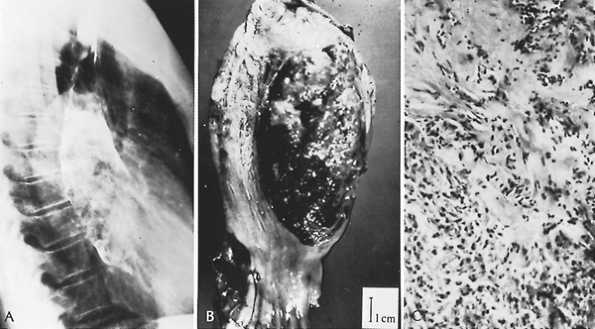 |
Fig. 153-13. Leiomyoblastoma. A. Barium swallow reveals a large polypoid mass within the middle one third of the esophagus. B. Surgical specimen shows a 9-cm polypoid tumor within the esophagus with necrotic and hemorrhagic changes on its surface. C. Photomicrograph of the pedicle portion of the polyp demonstrates cells containing eccentric nuclei with cytoplasmic vacuolization. (Hematoxylin and eosin stain, original magnification times 150.) From DeMeester TR, Skinner DB: Polypoid sarcomas of the esophagus. Ann Thorac Surg 20:405, 1975. With permission. |
Fibrosarcoma
Although fibrosarcoma was often cited in the early literature as the most common esophageal sarcoma, Stout and Lattes (1957) knew of no reliable report of primary fibrosarcoma arising in the esophagus. Few examples have been recorded since then, and it is likely that many earlier reports were examples of leiomyosarcoma. Goodner and associates (1963) reported one fibrosarcoma among 1,456 esophageal malignancies from 1926 through 1961. It is of interest that two reported patients received thyroid irradiation 29 and 30 years before the recognition of cervical esophageal fibrosarcoma. Long-term survival has been achieved with polypoid fibrosarcoma by wide surgical excision.
Chondrosarcoma
Yaghmai and Ghahremani (1976) reported a varicoid chondrosarcoma of the lower esophagus. Malignant degeneration of a cartilaginous tracheobronchial remnant was implicated in the pathogenesis of the tumor. Smith and associates (1976) reported the rare occurrence of cartilaginous nodules and rings (tracheobronchial choristoma), which may cause segmental stenosis of the esophagus in children. Cell aggregates of chondrosarcoma occasionally are found within esophageal polypoid carcinoma. Metaplasia of mesenchymal cells is considered the likely origin of such chondral tissues.
Other Sarcomas
Mansour and colleagues (1983) described a case of liposarcoma of the cervical esophagus. The presenting symptoms were respiratory, and the tumor was excised locally because the pedicle was not involved. These tumors have good prognoses after resection. Song and Miller (2002) reported a case of myxofibrosarcoma of the esophageus that was treated by local resection. McIntyre and associates (1982)
P.2335
described an osteosarcoma, a rare entity in the esophagus, as a polypoid mass in the lower esophagus of a 70-year-old man. This tumor had penetrated the muscular layers and was treated by esophagogastrectomy.
Umerah (1980) reported the case of a 23-year-old man with Kaposi's sarcoma of the foot and polypoid lesions in the lower half of the esophagus. An autopsy confirmed Kaposi's sarcoma of the esophagus. The relationship of Kaposi's sarcoma to acquired immunodeficiency syndrome (AIDS) was established early by Friedman-Kien and associates (1982). Kaposi's sarcoma is also associated with renal transplantation and immunosuppression. Pass and associates (1984) reported that 2 of 15 patients with AIDS had this lesion; one had cytomegalovirus esophagitis plus Kaposi's sarcoma of the esophagus, and the other had isolated Kaposi's sarcoma of the esophagus. Endoscopic biopsy may be of low yield secondary to the submucosal nature of these lesions. Most lesions will regress with a modification or regression in immunosuppressive therapy. Kaposi's sarcoma of the esophageus is usually clinically silent, but gross bleeding and and chronic anemia can occur, as described by Lin and associates (2002). Therapeutic approaches to gastrointestinal bleeding include injection therapy, heat coagulation, and histamine-2 blocker therapy. Pain, obstruction, or perforation can occur after local treatment of these lesions.
Perch and colleagues (1991) presented their experience with cases of esophageal sarcomas, describing the occurrence of a synovial sarcoma and of a tumor composed of a malignant schwannoma and areas of rhabdomyoblastic cells (the so-called triton tumor). After local resection and radiation therapy (and chemotherapy for triton tumor), both patients survived beyond 6 years. In a review of the literature on esophageal schwannomas, Saito and associates (2000) identified three reports that included a malignant schwannoma. Brooks and colleagues (1985) had described another triton tumor. Iwata (1993) and Morita (1995) and their co-workers each presented a case of an early malignant schwannoma that on microscopic studies revealed increased numbers of mitotic cells and nuclear atypia. Treatment consists of surgical resection when possible and postoperative irradiation. Patients with a triton tumor may be given additional chemotherapy.
Wyatt and associates (1991) reported the first case of malignant granular cell tumor of the esophagus without lymphatic involvement. The patient was alive 15 months after tumor resection. A more recent review of granular cell tumors of the esophagus has been reported by Goldblum and associates (1996). Malignant fibrous histiocytomas of the esophagus have been reported several times, most recently by Geboes and colleagues (1989).
LYMPHOMA
Involvement of the gastrointestinal tract, including the esophagus, by lymphoma and Hodgkin's lymphoma is found frequently at autopsy. In most instances, the disease is widespread and extensive. Less often, gastrointestinal involvement is clinically evident. The stomach, small bowel, colon, and esophagus are affected, in decreasing order of frequency. Lymphomas localized to the hollow viscus and its regional lymph nodes may be the only manifestations of disease, and these should be referred to as primary gastrointestinal lymphomas.
Primary malignant lymphoma of the esophagus is rare. Nevertheless, lymphocytic-histiocytic lymphosarcoma, reticulum cell sarcoma, and Hodgkin's (nodular sclerosing) lymphomas have been reported as primary tumors in the esophagus. Most patients are asymptomatic, but esophageal obstruction and perforation have been described. Lymphomatous infiltration of the distal esophageal myenteric plexus may simulate achalasia. Davis and associates (1975) reported dramatic clinical and manometric reversal with chemotherapy alone. Radiation therapy, chemotherapy, or both should be considered for most patients with esophageal lymphoma. Regression of the tumor is generally reported. Occasional reports of surgical resection in combination with chemotherapy or radiation therapy have appeared, without much change in the clinical outcome of these patients. Bernal and del Junco (1986) described four cases of non-Hodgkin's lymphoma in AIDS patients seen over a 9-month period, which demonstrates the increased occurrence of this tumor in the immunocompromised patient. Persistent symptomatic esophageal ulcers in AIDS patients that do not respond to steroid therapy should alert the clinician to the possibility of an esophageal lymphoma. The diagnosis can be established by endoscopic biopsy.
Extramedullary plasmacytomas of primary gastrointestinal origin are rare. Ahmed and colleagues (1976) documented the first primary extramedullary esophageal plasmacytoma in a 67-year-old man. The diagnosis of solitary primary plasmacytoma of the esophagus requires: (a) absence of Bence Jones proteinuria, (b) normal serum electrophoresis, (c) normal bone marrow biopsy, and (d) absence of distant metastases evident after liver scan and bone survey. Surgical excision is the treatment of choice for the obstructive lesion, with adjuvant radiation therapy if the lymph nodes are involved.
METASTATIC TUMORS TO THE ESOPHAGUS
Metastatic tumors to the esophagus usually result by direct extension from contiguous organs, such as the stomach, lung, pharynx, larynx, and thyroid, but they can occur by way of the mediastinal lymph nodes or by blood-borne metastasis. Metastatic lesions to the esophagus originating from the prostate, pancreas, testis, eye, tongue, tibia, liver, uterus, breast, skin, lung, and the wrist synovium have been described. Among the rare examples of metastasis from a distant tumor, breast carcinoma is by far the most common. The mechanism of lymphatic spread of carcinoma from the breast to the esophagus is uncertain, but the internal mammary chain may be involved in breast cancer, and progression
P.2336
to the periesophageal lymphatics by an intercostal pathway is possible.
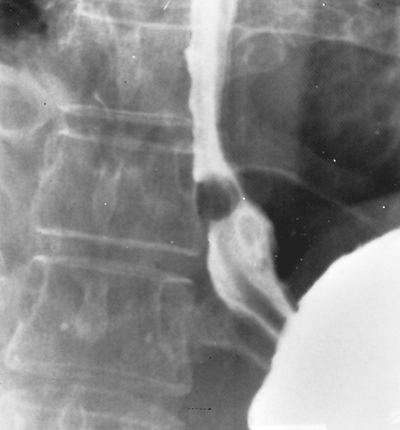 |
Fig. 153-14. Barium swallow demonstrates typical smooth filling of metastatic breast carcinoma in the distal esophagus. |
About one half of patients with metastatic involvement of the esophagus present with dysphagia. The esophagogram usually demonstrates a smooth concentric stricture or indentation of the esophageal lumen with intact mucosa (Fig. 153-14). Esophagoscopy demonstrates a smooth concentric or nodular narrowing without mucosal abnormality. Biopsies usually show only normal epithelium, and the risk for perforation is inordinately high. Polk and co-workers (1967) stated that the diagnosis of metastatic breast carcinoma may be accepted without histologic confirmation when the characteristic barium swallow and endoscopic findings are noted in a postmastectomy patient with dysphagia.
Bougienage is contraindicated for metastatic malignant lesions of the esophagus. Catastrophic perforation of a diffusely infiltrated, friable esophageal wall is often reported. Radiation therapy, with or without chemotherapy or hormone therapy, has produced significant improvement in some patients, depending on histology of the tumors. As endoscopic techniques have evolved, the use of laser therapy has become widely accepted to relieve obstruction and provide short-term improvement of dysphagia when more definitive therapy is not feasible. Additionally, endoscopic placement of intraluminal esophageal stents can reliably improve dysphagia and allow for improved control of secretions and avoidance of aspiration. In selected patients, surgical resection with restoration of alimentary continuity may be an acceptable alternative.
REFERENCES
Ahmed N, et al: Primary extramedullary esophageal plasmacytoma: first case report. Cancer 38:943, 1976.
Allard M, et al: Primary adenoid cystic carcinoma of the esophagus. Can J Surg 24:405, 1981.
Allen AC, Spitz S: Melanoma: a clinicopathologic study. Cancer 6:1, 1953.
Azzopardi JG, Menzies T: Primary esophageal adenocarcinoma: configuration of its existence by the finding of mucous gland tumors. Br J Surg 49:497, 1962.
Battifora H: Spindle cell carcinoma: ultrastructural evidence of squamous origin and collagen production by the tumor cells. Cancer 37:2275, 1976.
Bensch KG, et al: Oat-cell carcinoma of the lung: its origin and relationship to bronchial carcinoid. Cancer 22:1163, 1968.
Bernal A, del Junco GW: Endoscopic and pathologic features of esophageal lymphoma: a report of four cases in patients with acquired immune deficiency syndrome. Gastrointest Endosc 32:96, 1986.
Beyer KL, et al: Primary small-cell carcinoma of the esophagus. Report of 11 cases and review of the literature. J Clin Gastroenterol 13:135, 1991.
Biemond P, ten Kate FJW, van Blankenstein M: Esophageal verrucous carcinoma: histologically a low-grade malignancy but clinically a fatal disease. J Clin Gastroenterol 13:102, 1991.
Blot WJ, Devesa SS, Fraumeni JF Jr: Continuing climb in rates of esophageal adenocarcinoma: an update. JAMA 270:1320, 1993.
Blot WJ, McLaughlin JK: The changing epidemiology of esophageal cancer. Semin Oncol 26:2, 1999.
Bombi JA, et al: Adenosquamous carcinoma of the esophagus. A case report. Pathol Res Pract 187:514, 1991.
Brenner S, Heimlich H, Widman M: Carcinoid of esophagus. N Y State J Med 69:1337, 1969.
Brocheriou C, et al: Carcinome epith lial-myo pith lial des glands salivaires. tude de 15 observations et revue de la litt rature. Ann Pathol 11:316, 1991.
Brooks JSJ, Freeman M, Enterline HT: Malignant triton tumors. Natural history and immunohistochemistry of nine new cases with literature review. Cancer 55:2543, 1985.
Caldwell CB, Bains MS, Burt M: Unusual malignant neoplasms of the esophagus. Oat cell carcinoma, melanoma, and sarcoma. J Thorac Cardiovasc Surg 101:100, 1991.
Carrie A: Adenocarcinoma of the upper end of the esophagus arising from ectopic gastric epithelium. Br J Surg 37:474, 1950.
Casas F, et al: Primary small cell carcinoma of the esophagus. A review of the literature with emphasis on therapy and prognosis. Cancer 80:1366, 1997.
Chalkiadakis G, et al: Primary malignant melanoma of the esophagus. Ann Thorac Surg 39:472, 1985.
Chong FK, Graham JH, Madoff IM: Mucin-producing carcinoid ( composite tumor ) of upper third of esophagus: a variant of carcinoid tumor. Cancer 44:1853, 1979.
Cook MG, Eusebi V, Betts CM: Oat-cell carcinoma of the esophagus: a recently recognized entity. J Clin Pathol 29:1068, 1976.
Craig SR, et al: Primary small-cell cancer of the esophagus. J Thorac Cardiovasc Surg 109:284, 1995.
Davis JA, et al: Reversible achalasia due to reticulum-cell sarcoma. N Engl J Med 293:130, 1975.
De La Pava S, et al: Melanosis of the esophagus. Cancer 16:48, 1963.
DeMeester TR, Skinner DB: Polypoid sarcomas of the esophagus: a rare but potentially curable neoplasm. Ann Thorac Surg 20:405, 1975.
Devesa SS, Blot WJ, Fraumeni JF Jr: Changing patterns in the incidence of esophageal and gastric carcinoma in the United States. Cancer 83:2049, 1998.
El-Serag HB, et al: Epidemiological differences between adenocarcinoma of the oesophagus and adenocarcinoma of the gastric cardia in the USA. Gut 50:368, 2002.
Eng J, et al: Malignant melanoma metastatic to the esophagus. Ann Thorac Surg 48:287, 1989.
Friedman-Kien AE, et al: Disseminated Kaposi's sarcoma in homosexual men. Ann Intern Med 96:693, 1982.
Gaede JT, et al: Leiomyosarcoma of the esophagus. Report of two cases, one with associated squamous cell carcinoma. J Thorac Cardiovasc Surg 75:740, 1978.
Geboes K, et al: Primary malignant fibrous histiocytoma of the esophagus. J Surg Oncol 40:49, 1989.
Goethals PL, Harrison EG Jr, Devine KD: Verrucous squamous carcinoma of the oral cavity. Am J Surg 106:845, 1963.
Goldblum JR, et al: Granular cell tumors of the esophagus: a clinical and pathologic study of 13 cases. Ann Thorac Surg 62:860, 1996.
P.2337
Goldfarb TG: Esophageal gland adenocarcinoma of the mid-esophagus. Am J Clin Pathol 48:281, 1967.
Goldman JL, Marshak RH, Friedman AI: Primary adenocarcinoma of the esophagus simulating a benign lesion. JAMA 149:144, 1952.
Goodner JT, Miller TR, Watson WL: Sarcoma of the esophagus. AJR Am J Roentgenol Radium Ther Nucl Med 89:132, 1963.
Haleem A, et al: Paget's disease of the oesophagus associated with mucous gland carcinoma of the lower oesophagus. Histopathology 42:61, 2003.
Hama Y, et al: A case of primary small cell carcinoma of the cervical esophagus with long-term survival following concurrent chemoradiotherapy: case report and review of the literature. Tumori 85:284, 1999.
Herman J, et al: Primary malignant melanoma of the esophagus treated by endoscopic ablation and interferon therapy. Dis Esophagus 14:239, 2001.
Hewlett AW: The superficial glands of the esophagus. J Exp Med 5:319, 1900.
Hoang MP, et al: Carcinoid tumor of the esophagus: a clinicopathologic study of four cases. Am J Surg Pathol 26:517, 2002.
Huncharek M, Muscat J: Small cell carcinoma of the esophagus. The Massachusetts General Hospital experience, 1978 to 1993. Chest 107: 179, 1995.
Iwata H, et al: Esophageal schwannoma. Ann Thorac Surg 56:375, 1993.
Jemal A, et al: Cancer statistics, 2002. CA Cancer J Clin 52:23, 2002.
Johanet H, et al: Leiomyosarcoma of the esophagus 8 years after the diagnosis of a leiomyoma. Gastroenterol Clin Biol 15:780, 1991.
Johns BAE: Developmental changes in the esophageal epithelium in man. J Anat 86:29, 1952.
Joob AW, et al: Primary malignant melanoma of the esophagus. Ann Thorac Surg 60:217, 1995.
Juarez F, et al: Adenocarcinoma in situ y adenocarcinoide de es fago originado en epitelio de Barrett. Informe de un caso. Rev Invest Clin 38: 303, 1986.
Kimura N, et al: Myogenic expression in esophageal polypoid tumors. Arch Pathol Lab Med 113:1159, 1989.
Lieberman MD, et al: Carcinoma of the esophagus. Prognostic significance of histologic type. J Thorac Cardiovasc Surg 109:130, 1995.
Lin CH, et al: Esophageal and gastric Kaposi's sarcoma presenting as upper gastrointestinal bleeding. Cheng Gung Med J 25:329, 2002.
Lindberg GM, et al: Atypical carcinoid of the esophagus: a case report and review of the literature. Cancer 79:1476, 1997.
Makino H, et al: Effectiveness of preoperative chemotherapy using (CBDCA) and surgery against an esophageal small cell carcinoma. Dis Esophagus 15:237, 2002.
Malik AB, et al: Long-term survival in a patient with verrucous carcinoma of the esophagus. Am J Gastroenterol 91:1031, 1996.
Mansour KA, et al: Pedunculated liposarcoma of the esophagus: a first case report. J Thorac Cardiovasc Surg 86:447, 1983.
Martin MR, Kahn LB: So-called pseudosarcoma of the esophagus. Arch Pathol Lab Med 101:604, 1977.
Matsusaka T, Watanabe H, Enjoji M: Anaplastic carcinoma of the esophagus: report of three cases and their histogenetic consideration. Cancer 37:1352, 1976a.
Matsusaka T, Watanabe H, Enjoji M: Pseudosarcoma and carcinosarcoma of the esophagus. Cancer 37:1546, 1976b.
Matsutani T et al: Primary malignant melanoma of the esophagus treated by esophagectomy and systemic chemotherapy. Dis Esophagus 14:241, 2001.
McIntyre M, Webb JN, Browning GC: Osteosarcoma of the esophagus. Hum Pathol 13:680, 1982.
McKechnie JC, Fechner RE: Choriocarcinoma and adenocarcinoma of the esophagus with gonadotropin secretion. Cancer 27:694, 1971.
McKeown F: Oat-cell carcinoma of the esophagus. J Pathol Bacteriol 64: 889, 1952.
Meyerowitz BR, Shea LT: The natural history of squamous verrucose carcinoma of the esophagus. J Thorac Cardiovasc Surg 61:646, 1971.
Miettinen M, et al: Esophageal stromal tumors: a clinicopathologic, immunohistochemical, and molecular genetic study of 17 cases and comparison with esophageal leiomyomas and leiomyosarcomas. Am J Surg Pathol 24:211, 2000.
Ming S: Tumors of the esophagus and stomach. Fascicle 7. Washington, DC: Armed Forces Institute of Pathology, 1973.
Minielly JA, et al: Verrucous squamous cell carcinoma of the esophagus. Cancer 20:2078, 1967.
Mitani M, et al: Long-term survivors after the resection of limited esophageal small cell carcinoma. Dis Esophagus 13:259, 2000.
Morita I, et al: A case of the esophageal submucosal schwannoma with pathologic malignant finding. Geka 58:506, 1995.
Nishimaki T, et al: Tumor spread and outcome of treatment in primary esophageal small cell carcinoma. J Surg Oncol 64:130, 1997.
Osamura RY, et al: Polypoid carcinoma of the esophagus: a unifying term for carcinosarcoma and pseudosarcoma. Am J Surg Pathol 2:201, 1978.
Osborn NK, et al: Verrucous carcinoma of the esophagus: clinicopathophysiologic fratures and treatment of a rare entity. Dig Dis Sci 48: 465, 2003.
Pass HT, et al: Thoracic manifestations of the acquired immune deficiency syndrome. J Thorac Cardiovasc Surg 88:654, 1984.
Pantvaidya GH, et al: Small cell carcinoma of the esophagus: the Tata Memorial Hospital experience. Ann Thorac Surg 74:1924, 2002.
Perch SJ, et al: Esophageal sarcomas. J Surg Oncol 48:194, 1991.
Piccone VA, et al: Primary malignant melanoma of the esophagus associated with melanosis of the entire esophagus. First case report. J Thorac Cardiovasc Surg 59:864, 1970.
Polk HC Jr, Camp FA, Walker AW: Dysphagia and esophageal stenosis: manifestation of metastatic mammary cancer. Cancer 20:2002, 1967.
Postlethwait RW: Surgery of the Esophagus. 2nd Ed. New York: Appleton-Century-Crofts, 1986.
Postlethwait RW, Musser AW: Changes in the esophagus in 1,000 autopsy specimens. J Thorac Cardiovasc Surg 68:953, 1974.
Raphael HA, Ellis FH Jr, Dockerty MB: Primary adenocarcinoma of the esophagus. Ann Surg 162:785, 1966.
Rector LE, Connerly ML: Aberrant mucosa in the esophagus in infants and in children. Arch Pathol Lab Med 31:285, 1941.
Sabanathan S, Eng J: Primary malignant melanoma of the esophagus. Scand J Thorac Cardiovasc Surg 24:83, 1990.
Saito R, et al: Esophageal schwannoma. Ann Thorac Surg 69:1947, 2000.
Sasajima K, et al: Rapid growth of a pseudosarcoma of the esophagus. J Clin Gastroenterol 10:533, 1988.
Sasajima K, et al: Polypoid squamous cell carcinoma of the esophagus. Cancer 64:94, 1989.
Sato T, et al: Small cell carcinoma (non-oat cell type) of the esophagus concomitant with invasive squamous cell carcinoma and carcinoma in situ. Cancer 57:328, 1986.
Schneider A, Martini N, Burt ME: Malignant melanoma metastatic to the esophagus. Ann Thorac Surg 55:516, 1993.
Scicchitano LP, Camishion RC: Primary adenocarcinoma of the esophagus. Am J Surg 104:531, 1962.
Shields TW, Eilert JB, Battifora H: Pseudosarcoma of the oesophagus. Thorax 27:472, 1972.
Smith CW, Murray GF, Wilcox BR: Intramural esophageal hamartoma. An unusual cause of progressive stricture in a child. J Thorac Cardiovasc Surg 72:315, 1976.
Sobin LH: Histologic Typing of Gastric and Oesophageal Tumours. Geneva: World Health Organization, 1977.
Soga J: Esophageal endocrinomas, an extremely rare tumor: a statistical comparative evaluation of 28 ordinary carcinoids and 72 atypical variants. J Exp Clin Cancer Res 17:47, 1998.
Song HK, Miller JI: Primary myxofibrosarcoma of the esophagus. J Thorac Cardiovasc Surg 124:196, 2002.
Stout AP, Lattes R: Atlas of tumor pathology: tumors of the esophagus. Section 5, Fascicle 20. Washington, DC: Armed Forces Institute of Pathology, 1957.
Tateishi R, et al: Argyrophil cells and melanocytes in esophageal mucosa. Arch Pathol Lab Med 98:87, 1974.
Tateishi R, et al: Argyrophil cell carcinoma (APUDoma) of the esophagus: a histopathologic entity. Virchows Arch [A] 371:283, 1976.
Turnbull ADM, Goodner JT: Primary adenocarcinoma of the esophagus. Cancer 22:915, 1968.
Umerah BC: Kaposi sarcoma of the oesophagus. Br J Radiol 53:807, 1980.
Wyatt MG, et al: Malignant granular cell tumor of the oesophagus. Eur J Surg Oncol 17:388, 1991.
Xiaogang Z, et al: Atypical carcinoid of the esophagus: report of a case. Ann Thorac Cardiovasc Surg 8:302, 2002.
Yachida S, et al: Long-term survival after resection for small cell carcinoma of the esophagus. Ann Thorac Surg 72:596, 2001.
Yaghmai I, Ghahremani GG: Chondrosarcoma of the esophagus. AJR Am J Roentgenol 126:1175, 1976.
Yates DR, Kloss LG: Paget's disease of the oesophageal epithelium: report of the first case. Arch Pathol 86:447, 1968.
P.2338
Reading References
Adenocarcinoma
Blot WJ, et al: Rising incidence of adenocarcinoma of the esophagus and gastric cardia. JAMA 265:1287, 1991.
Cameron JL, et al: Carcinoma arising in Barrett's esophagus. Surg Gynecol Obstet 161:570, 1985.
Cerar A, Jutersek A, Vidmar S: Adenoid cystic carcinoma of the esophagus. A clinicopathologic study of three cases. Cancer 67:2159, 1991.
Dawson JL: Adenocarcinoma of the middle oesophagus arising in an oesophagus lined by gastric (parietal) epithelium. Br J Surg 51:940, 1940.
Faintuch J, Shepard KV, Levin B: Adenocarcinoma and other unusual variants of esophageal cancer. Semin Oncol 11:196, 1984.
Kelson D: Multimodality therapy for adenocarcinoma of the esophagus. Gastroenterol Clin North Am 26:635, 1997.
Lortat-Jacob JL, et al: Primary esophageal adenocarcinoma: report of 16 cases. Surgery 64:535, 1968.
Magovern CJ, et al: Primary inflammatory fibrosarcoma of the esophagus. Ann Thorac Surg 62:1848, 1996.
McCorkle RG, Blades B: Adenocarcinoma of the esophagus arising in aberrant gastric mucosa. Am J Surg 21:781, 1955.
Petursson SR: Adenoid cystic carcinoma of the esophagus. Complete response to combination chemotherapy. Cancer 57:1464, 1986.
Shah R, et al: Rhabdomyosarcoma of the oesophagus. A case report. J Cardiovasc Surg 36:99, 1995.
Sjogren RW Jr, Johnson LF: Barrett's esophagus: a review. Am J Med 74:313, 1983.
Takubo K, et al: Morphological heterogeneity of esophageal carcinoma. Acta Pathol Jpn 39:180, 1989.
Variants of Squamous Cell Carcinoma
Agha FP, Keren DF: Spindle-cell squamous carcinoma of the esophagus: a tumor with biphasic morphology. AJR Am J Roentgenol 145:541, 1985.
Enrile FT, et al: Pseudosarcoma of the esophagus (polypoid carcinoma of esophagus with pseudosarcomatous features). Cancer 31:1197, 1973.
Lieberman MD, et al: Esophageal carcinoma. The unusual variants. J Thorac Cardiovasc Surg 108:1138, 1994.
Odes HD, et al: Varicoid carcinoma of the esophagus. Am J Gastroenterol 73:141, 1980.
Olmsted WW, Lichtenstein JE, Hyams VJ: Polypoid epithelial malignancies of the esophagus. AJR Am J Roentgenol 140:921, 1983.
Parkinson AT, Hadiak GL, McInerney RP: Verrucous squamous cell carcinoma of the esophagus following lye stricture. Chest 57:489, 1970.
Postlethwait RW, Wechsler AS, Shelburne JD: Pseudosarcoma of the esophagus. Ann Thorac Surg 19:198, 1975.
Razzuk MA, et al: Pseudosarcoma of the esophagus: a case report. J Thorac Cardiovasc Surg 61:650, 1971.
Talbert JL, Cantrell JR: Clinical and pathologic characteristics of carcinosarcoma of the esophagus. J Thorac Cardiovasc Surg 45:1, 1963.
Small Cell Carcinoma
Azzopardi JG, Pollock DJ: Argentaffin and argyrophil cells in gastric carcinoma. J Pathol 86:443, 1963.
Bennouna J, et al: Small cell carcinoma of the esophagus: analysis of 10 cases and review of the published data. Am J Clin Oncol 23: 455, 2000.
Ho KJ, et al: Small cell carcinoma of the esophagus: evidence for a unified histogenesis. Hum Pathol 15:460, 1984.
Horai T, et al: A cytologic study on small cell carcinoma of the esophagus. Cancer 41:1890, 1978.
Ibrahim NB, Briggs JC, Corbishley CM: Extrapulmonary oat-cell carcinoma. Cancer 54:1645, 1984.
Imura H, et al: Studies on ectopic ACTH-producing tumors. II. Clinical and biochemical features of 30 cases. Cancer 35:1430, 1975.
McFadden DW, Rudnicki M, Talamini MA: Primary small cell carcinoma of the esophagus. Ann Thorac Surg 47:477, 1989.
Medgyesy CD, et al: Small cell carcinoma of the esophagus: the University of Texas M. D. Anderson Cancer Center experience and literature review. Cancer 88:62, 2000.
Mulder LD, Gardiner GA, Weeks DA: Primary small cell carcinoma of the esophagus: case presentation and review of the literature. Gastrointest Radiol 16:5, 1991.
Melanoma
DasGupta TK, Brasfield RD, Paglia MA: Primary melanomas in unusual sites. Surg Gynecol Obstet 128:841, 1969.
Frable WJ, Kay S, Schatzki P: Primary malignant melanoma of the esophagus: an electron microscopic study. Am J Clin Pathol 58:659, 1972.
Guzman RP, et al: Primary malignant melanoma of the esophagus with diffuse melanocytic atypia and melanoma insitu. Am J Clin Pathol 92:802, 1989.
Montgomery ACV: Primary malignant melanoma of the oesophagus. Clin Oncol 2:239, 1976.
Saibil E, Palayew MJ: Primary malignant melanoma of the esophagus. Am J Gastroenterol 61:63, 1974.
Stranks GJ, Mathai JT, Rowe-Jones DC: Primary malignant melanoma of the esophagus: case report and review of surgical pathology. Gut 32:828, 1991.
Wood CB, Wood RAB: Metastatic malignant melanoma of the esophagus. Am J Dig Dis 20:786, 1975.
Sarcomas
Almeida JM: Leiomyosarcoma of the esophagus. Chest 81:761, 1982.
Athanasoulis CA, Aral IM: Leiomyosarcoma of the esophagus. Gastroenterology 54:271, 1968.
Borrie J: Sarcoma of esophagus: surgical treatment. J Thorac Surg 37:413, 1959.
Caldwell CB, Bains MS, Burt M: Unusual malignant neoplasms of the esophagus. Oat cell carcinoma, melanoma, and sarcoma. J Thorac Cardiovasc Surg 101:100, 1991.
Choh JH, Khazei AH, Ihm HJ: Leiomyosarcoma of the esophagus: report of a case and review of the literature. J Surg Oncol 32:223, 1986.
Freitag M, Herzog KH, Zuber B: Esophagus carcinoid a rare differential diagnosis in malignant esophageal neoplasia [in German]. Chirug 66:59, 1995.
Horing E, et al: Carcinoid tumor of the esophagus. A rare differential diagnosis in submucosal esophageal tumor [in German]. Z Gastroenterol 28:10, 1990.
Partensky C, et al: Five-year survival after transhiatal resection of esophageal carcinoid tumor with a lymph node metastasis. Cancer 72:2320, 1993.
Rankin R, Nirodi NS, Browne MK: Carcinoid tumour of the oesophagus: report of a case. Scott Med J 25:245, 1980.
Ready AR, et al: Malignant carcinoid tumour of the oesophagus. Thorax 44:594, 1989.
Tanida S, et al: Carcinoid of the esophagus located in lamina propria. J Gastroenterol 33:541, 1998.
Turnbull AD, et al: Primary malignant tumors of the esophagus other than typical epidermoid carcinoma. Ann Thorac Surg 15:463, 1973.
Wobbes T, et al: Rhabdomyosarcoma of the esophagus. Arch Chir Neerl 27:69, 1975.
Lymphoma
Agha FP, Schnitzer B: Esophageal involvement in lymphoma. Am J Gastroenterol 80:412, 1985.
Allen AW, et al: Primary malignant lymphoma of the gastro-intestinal tract. Ann Surg 140:428, 1954.
Carnovale RL, et al: Radiologic manifestations of esophageal lymphoma. AJR Am J Roentgenol 128:751, 1977.
Freeman C, Berg JW, Cutler SJ: Occurrence and prognoses of extranodal lymphomas. Cancer 29:252, 1972.
P.2339
Gedgaudas-McClees RK, Maglinte DDT: Lymphomatous esophageal nodules: the difficulty in radiological differential diagnosis. Am J Gastroenterol 80:529, 1985.
Gupta NM, et al: Primary lymphoma of the esophagus. J Clin Gastroenterol 23:203, 1996.
Kirsch HL, et al: Esophageal perforation: an unusual presentation of esophageal lymphoma. Dig Dis Sci 28:371, 1983.
Mengoli M, et al: Primary non-Hodgkin's lymphoma of the esophagus. Am J Gastroenterol 85:737, 1990.
Moses AE, et al: Primary lymphoma of the esophagus in a patient with AIDS. J Clin Gastroenterol 21:327, 1995.
Nissan S, Bar-Moar JA, Levy E: Lymphosarcoma of the esophagus: a case report. Cancer 34:1321, 1974.
Pearson JM, Borg-Grech A: Primary Ki-1 (CD 30)-positive, large cell, anaplastic lymphoma of the esophagus. Cancer 68:418, 1991.
Stein HA, Murray D, Warner HA: Primary Hodgkin's disease of the esophagus. Dig Dis Sci 26:457, 1981.
Weyand CM, Goronzy JJ, Huchzermeyer H: Presentation of an unrecognized lymphoma as esophageal tumor. Endoscopy 18:61, 1986.
Worgan D, Baldock CR: Lymphosarcoma of the esophagus. J Laryngol Otol 90:207, 1976.
Metastatic Tumors
Atkins JP: Metastatic carcinoma to the esophagus: endoscopic considerations with special reference to carcinoma of the breast. Ann Otolaryngol Rhinol Laryngol 75:356, 1966.
Biller HF, et al: Breast carcinoma metastasizing to the cervical esophagus. Laryngoscope 92:999, 1982.
Gore RM, Sparberg M: Metastatic carcinoma of the prostate to the esophagus. Am J Gastroenterol 77:358, 1982.
Laforet EG, Kondi ES: Postmastectomy dysphagia. Am J Surg 121:368, 1971.
Orringer MB, Skinner DB: Unusual presentations of primary and secondary esophageal malignancies. Ann Thorac Surg 11:305, 1971.
Vansant JH, Davis RK: Esophageal obstruction secondary to mediastinal metastasis from breast carcinoma. Chest 60:93, 1971.
Zarian LP, Berliner L, Redmond P: Metastatic endometrial carcinoma to the esophagus. Am J Gastroenterol 78:9, 1983.
EAN: 2147483647
Pages: 203